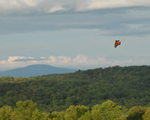|
|
| Migration
Update: August 31, 2007 |
Please
Report
Your Sightings! >> |
Today's
Report Includes:
|

How
much farther must this monarch fly? >> |
|
The Migration: Maps, Questions and Highlights |
|
|
Distribution
Map >> |
.
|
Map
Questions >>
|
Highlights:
The Migration Moves into xx.
Welcome
to the Journey South fall migration season, and thank you for
helping to track the monarch's migration to Mexico.
First
signs of migration:
Although it seemed early, the reports appeared on the
map and the telltale signs of migration were clear. Notice what
people watch for:
8/5/07
Brooklyn Park, MN (45 N, -93 W)
"I observed a fresh-looking monarch about
40-50 feet up flying south in a most determined pathway,"
wrote Minnesota's Oscar Johnson, a Master Birder and former
teacher.
8/5/07
Grygla, MN (48 N, -95 W)
"On August 5, most of the recently
emerged monarchs in extreme northern Minnesota were exhibiting
southward migratory behavior and evening clustering behavior,"
noted Paul Cherubini.
By mid-August, monarchs were roosting at points across the north.
In Ontario, South Dakota, Minnesota, Wisconsin, Michigan, New York
and Vermont people saw monarchs like these:
8/19/07
Mississauga, ON (44 N, -80 W)
"Hundreds of monarchs flying and checking
out flowers in the garden, then finding each other and landing
and roosting in a silver Maple tree on the same branches. When
they closed their wings they looked like dried leaves. It was
spectacular to witness."
Monarchs
reappear in the south:
At the same time, people began to report their first
monarchs of the season in southern states like Texas, Georgia
and Alabama. Why now? Because monarchs are absent or scarce during
the summer months, then reappear sometime in August. This is what
caused the curious pattern you see on the map, with a gap across
the mid-latitudes. It's clear that monarchs are migrating in the
north, and the first may be arriving in the south, but its difficult
to tell if they are traveling in the gap between.
Get
ready for the challenge!
Fall migration can be tricky to track. Observations like these
raise interesting questions. Read about the three maps we'll be
making this fall and some challenges of tracking migration.
|
|
| Slideshow:
When, Where and How to Watch Migration
>> |
| You
can lie on your back and watch monarchs travel overhead. You can
count them as they feed in your garden. You may host monarchs as
guests in an overnight roost— or you may have to travel to
find them.
Here
are ways to watch for migrating monarchs. Please keep your eyes
on the skies and tell us what you see!
Slideshow
>> |

|
|
| Challenge
Question #1:
Who saw a stronger migration? |
|
Can you solve
this puzzle now that you know more about recording data as you track monarch
migration?
- John saw
80 monarchs and Mary saw 79, but Mary saw a stronger migration. How
can that be?
- What missing
information do you need about John and Mary’s observations to
explain this? Why is that information so important?
Write
in your journal and send
us your answer for possible inclusion in next week's update. |
| Links:
This Week's Monarch Resources |
- Book
and Slideshow: The Magic of Monarch Migration >>
- Migration
Math: How
Much Farther? >>
- Coming
Next Week: Migration
Rate Math >>
- Monarchs
for Kids
(booklets, photos, videos) >>
- Orientation:
Welcome to new participants! >>
|
| |
|
The
Next Monarch Migration Update Will Be Posted on September 7, 2007. |









